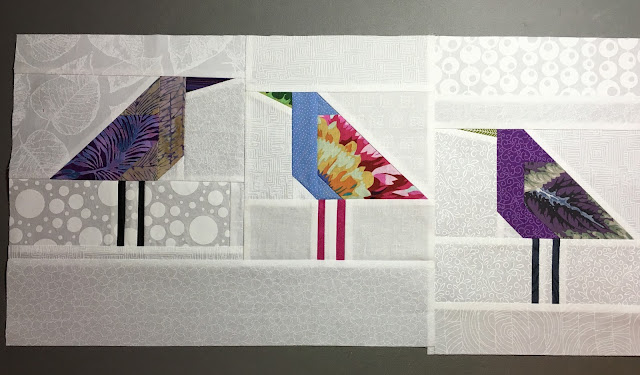"Did you use set-in squares?" one of my students asked me last weekend.
"Yeah, but not as many as you'd think," I replied. "I think there were only four or five."
At which point I tried to find them, but I had a hard time.
So here, dear readers, is how I did it.
I printed a photo (I only have a black and white printer) and drew out the outline of each bird block.
Then I tried to figure out how best to sew them together in the biggest possible chunks. I knew I could trim some legs down, and the white strip on the top of each bird's head could also be shrunk, but I did not disassemble or trim any of my bird blocks.
Next, using a variety of patterns, I filled in the spaces with squiggles, indicating how much extra WOW fabric I had to sew to each bird block to get it ready to sew to it's neighbors. The solid squares would be the set-in squares.
Here you can see the places I added to each of these three bird blocks. I also used my drawing to assemble some of the big basic "panels" of the quilt. I don't measure with a ruler, I measure by eye. It's a skill I learned when I was learning how to draw. I know it makes people crazy to hear that, but it's true. I move my pieces around next to each other, compare them to my drawing, and I can tell right away if it's OK or not. And in true free-piecing fashion, I always make my pieces BIGGER. That way I have enough room to trim down to size without freaking out.
You can see an example of my set in squares here. One thing I did quite deliberately was to use very strongly patterned WOW's for the set in squares. Dunno why I decided to use them that way. Maybe I was just in the mood to say HAHAHAHA if anybody pointed them out. I'm prickly like that.
Just because I laid out my design that way, doesn't mean I SEWED it that way. Here is proof:
One one side is the layout I designed, on the other is the layout once it was sewn together. Can you tell the difference? There are one or two tell-tale signs, but the changes were not arbitrary or accidental. As I was working I saw some elements that were not as successful as I felt they could have been, so I made changes. I also made some changes to make sewing it together easier. Hey, 50 shades notwithstanding, I'm not into punishment.
This is the way the quilt is sewn together. I used only five set-in squares. The quilt was made in three large "chunks." The first third, with its bottom row one straight seam across. Then the next row is also lone long horizontal strip.
When I got to the bottom third I knew there had to be an easier way than the complex arrangement I originally had, so I broke it down into big pieces and made the big center block (with the upside down birds) first, then added it to the three big pieces next to it. After that it was simple to put the last chunk together and sew it to the rest of the quilt.
You can read more in depth explanation of the process here, when I was actually sewing the flimsy together. I can either SEW, or I can try to remember to stop to take pictures. Usually once I get going I completely forget to take pictures.
Is it hard? Not really. Is it fussy? Damn straight. Is it worth it? Hell yeah.
If you want to make your own unique birds, you can buy the tutorial, Lynne's Liberated Birds, here, in my Etsy shop.









4 comments:
Yes, so true, every word, and I thought that I might just be the very FIRST to go to Lynne's Etsy and buy her Liberated Birds Tutorial. Not so, a few others beat me , but it is a wonderful, well written tute, with humour, clear instructions, and I have a bird on the way. Admittedly, not finished, but life, meals, shopping and that dreaded stuff called housework managed to squeeze in. So hop or fly on over, and get your own. Lynne, thanks for today's post, wonderful to see how you did the layout.
That's a beautiful quilt!
We still have our Gizzy quilts. We love them!
Excellent post (both of them) -- really shows how to work out the "fitting it all together" phase of free pieced quilts. And I agree with Nancy J -- GO GET THE TUTORIAL. Lynne taught me to make birds and I've made a couple dozen on my own (and I still use the tutorial for quick reference). I especially like this new enhanced version of the tutorial with ALL the extra notes, hints, suggestions, and variations.
Really great quilt and thanks for showing us your creative process. The end result was so worth it.
tushay3 (at) yahoo (dot) com
Post a Comment